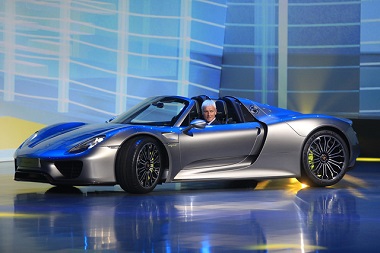Porsche $845,000 Hybrid Beats Prius as Hot Rods Go Green
 Speedy new models from Porsche AG and Bayerische Motoren Werke AG (BMW) can beat Toyota Motor Corp. (7203)’s Prius not just off the line but also at the fuel pump as efficiency becomes a key standard even for elite racers.
Speedy new models from Porsche AG and Bayerische Motoren Werke AG (BMW) can beat Toyota Motor Corp. (7203)’s Prius not just off the line but also at the fuel pump as efficiency becomes a key standard even for elite racers. Porsche’s $845,000 918 Spyder hybrid, unveiled at the International Auto Show in Frankfurt, can reach 100 kilometers (62 miles) per hour in 2.8 seconds and gets the equivalent of about 72 miles per gallon, based on European fuel-economy data. That tops the 50 mpg of the basic Prius hybrid.
BMW in Frankfurt introduced the i8, a plug-in hybrid racer that will get more than 113 miles per gallon when sales start next year, versus 95 mpg for the Prius plug-in. The models will join other elite electrics and hybrids such as Ferrari’s 1 million-euro ($1.32 million) LaFerrari and Mercedes’ 416,500-euro SLS AMG Coupe Electric Drive.
These ultra-efficient sportsters help automakers meet tougher emissions regulations without sacrificing power and performance. And they break the association between speed and pollution, shoring up the carmakers’ reputations for innovation, which have helped them sidestep a six-year decline in the European car market while underpinning their ability to charge premium prices and haul in above-average profits.
“We are standing at the dawn of a new era,” BMW Chief Executive Officer Norbert Reithofer told reporters today at the show. “We believe in electro-mobility and will bring it on the road.”
Green Efforts
The Frankfurt show, which starts today and runs through Sept. 22, brings together almost 1,100 manufacturers and suppliers and will feature 159 world premieres, according to the exhibition organizer.
Alongside the green efforts, BMW, Mercedes and Audi are all plotting large-scale expansions of their high-performance units, which make souped-up versions of their cars, to boost sales and earnings to help pay for the development of new technology.
“Demand is growing for high-performance cars especially in markets like China, the U.S. and the Middle East,” said Falk Frey, an analyst at ratings agency Moody’s Corp. in Frankfurt. “The profit margins manufacturers reap with these vehicles are very attractive.”
Sport Quattro
In Frankfurt, Audi is showing a concept called the Sport Quattro, a plug-in hybrid coupe with a 700-horsepower drivetrain. The combined thrust of the combustion and electric motors accelerate the car to 100 kph in 3.7 seconds. Its mileage of about 94 mpg is meant to demonstrate that efficiency and performance can go hand in hand.
“The one thing doesn’t rule out the other,” Axel Strotbek, Audi’s chief financial officer, said of the company’s push to raise its image with sportier models while at the same time cutting overall emissions.
Audi’s high-performance Quattro unit plans to roll out more models like the RS 5 convertible, the RS 7 coupe and RS Q3 sport-utility vehicle. The effort is being flanked by the introduction of a plug-in hybrid version of the A3 compact as VW plans to roll out the technology across the group.
VW is betting “that plug-in hybrids offer the best bridging technology” until pure-electric cars become more viable, said Tim Urquhart, an analyst with IHS Automotive in London. With demand for such vehicles still low, carmakers “hope the new market entrants launched at Frankfurt will create a tipping point.”
Panamera Plug-In
The limited-run Spyder hybrid will be Porsche’s most expensive model ever when deliveries start at the end of this year. The car follows on a plug-in hybrid version of the Panamera four-door coupe. The 918 combines a gasoline engine with two electric motors for a total of 887-horsepower to push the car to a top speed of 198 miles per hour.
“With this exclusive super sports car, Porsche is pushing the limit of what’s technically possible,” said Matthias Mueller, head of Volkswagen AG (VOW)’s Porsche brand. “We’ll prove even to critical observers that sports cars have a great electric future,” Mueller said at a briefing in Stuttgart, Germany, ahead of the 918’s show debut.
BMW’s i8, which was featured in the latest “Mission: Impossible” movie, combines a 131-horsepower electric motor to turn the front wheels with a 231-horsepower, three-cylinder gasoline engine for the rear. It accelerates to 100 kph in 4.5 seconds and can drive 35 kilometers solely on electric power. The i8, which BMW said today will cost $135,925, is the second model in BMW’s efficiency-focused “i” subbrand after the battery-powered i3 city car.
Uniqueness ‘Challenge’
“We’ve created a sports car with the consumption of a small car,” Herbert Diess, BMW’s development chief, said today in an interview in Frankfurt. “The biggest challenge was that there wasn’t any previous model at all,” as the company developed the carbon-fiber body with a low center of gravity, a gull-wing door and a three-cylinder engine. “Now is the right time for electric cars.”
The Munich-based carmaker will also bring to market a plug-in hybrid version of the X5 sport-utility vehicle in 2015, reflecting the company’s intention to introduce the technology in its mainstream models. “The plug-in hybrid is already standard for us, and a version will be included in every model series,” Diess said.
“BMW is leading in terms of innovation,” said Hans-Peter Wodniok, an analyst at Fairesearch GmbH in Kronberg, Germany. “While Audi and Mercedes are lagging, BMW’s power to innovate is one of reasons for its success.”
You can return to the main Market News page, or press the Back button on your browser.

